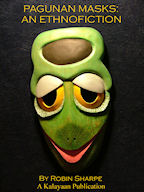Usually, a coffin mask representing the spirit, or essence, of the person was placed on the outfacing end of the coffin. Early chroniclers report great walls of masks creating a spectacular, and sometimes eerie, effect. Most were fairly simple masks carved from darle but much more elaborate and durable ones carved from cedar were used particularly after the Pagu acquired the steel blades needed for working this harder wood. Beginning around the middle of the Nineteenth Century the coffins were vandalized and the masks were removed to sell to collectors. Only a few hundred, mainly in the more remote caves, survived intact to when the first serious studies began in the 1890's. While the large collection in the Schwartz Museum in Hamburg was destroyed in the war, hundreds of other survive in private collections.

